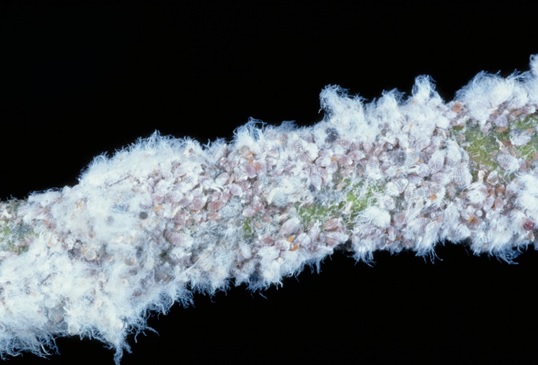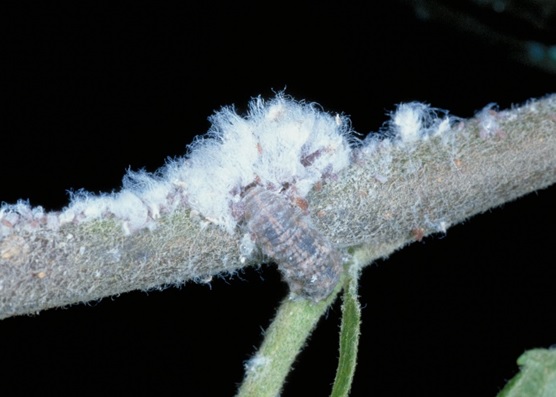Woolly Apple Aphid
ENTFACT-219: Woolly Apple Aphid | Download PDF
by Ric Bessin, Extension Specialist, and John Hartman, Extension Plant Pathologist
University of Kentucky College of Agriculture
The woolly apple aphid differs from other apple aphids in appearance, life cycle, and the type of damage inflicted. A colony appears as a cottony mass generally clustered in wounds and pruning scars on the trunk and branches of the tree. The aphids themselves are purplish in color surrounded by white, cottony, thread-like secretions. Woolly apple aphid is a sucking insect pest that weakens the tree by feeding on limbs and roots. It gets its name from the woolly appearance of its colonies. Long strands of white wax are produced that help to protect the colony of purple aphids from predators and pesticide sprays.

Figure 1. Infestations may be intense near the center of the tree.
Woolly apple aphid is a serious pest of apples, particularly young trees. Colonies form at wound sites on trunks, limbs, and twigs, where they feed on tender bark. Pruning and hail damage can create the wound sites for attack by this pest. Egg-laying wounds by the periodical cicada are ideal sites for infestation. As populations grow, aphids are commonly found on water sprouts in the center of the tree. The tree will begin to swell and form galls at the feeding sites.
As the number of aphids on the above ground portion of the tree increase, many work their way down to the roots and trunk below ground surface. It is the feeding on the roots that produces the greatest damage. Mature trees usually suffer little damage from the root infestations, but the root infestations are very damaging to young trees. Control of these aphids is very difficult when they attack the roots. Yellowish foliage is a sign that woolly apple aphid may be infesting roots. The root systems of nursery stock can be damaged, and severe root infestations can stunt or kill young trees. Infested trees often have short fibrous roots, which predisposes them to being easily uprooted. Swollen galls also form on roots; galls increase in size from year to year and are sites where fungi can attack. Aphid feeding on the root systems also disrupts the nutrient balance of root tissue, which can affect growth of other parts of the tree. Trees can have above-ground infestations of woolly apple aphid but no root infestations. Rootstocks vary in susceptibility to woolly apple aphid and susceptible rootstocks will form galls around the infestation sites. Use M111 or M106 if woolly apple aphid is a serious problem. Rootstocks appearing more susceptible to woolly apple aphid infestation include B9, M9, M26 and the P series.
During the summer, repeated woolly apple aphids generations of wingless individuals are produced. In the fall, winged individuals are produced which fly to search for elms on which to lay overwintering eggs, while some wingless forms may remain on both above and below ground parts of the apple tree throughout the winter.

Figure 2. A colony with the wax removed to reveal the live pinkish-purple aphids.
Woolly apple aphid colonies produce honeydew, which results in development of black sooty mold. The wax and the honeydew are bothersome to pickers when it brushes off the tree and onto clothing of pickers.
Monitoring
It is relatively easy to find where the colonies have formed. When monitoring for woolly apple aphid, examine four pruning scars on each of 5 scaffold limbs per tree. Carefully examine woolly apple aphid colonies to determine if live aphids are present. Predators, such as lady beetles, hover fly larvae, and lacewing larvae can completely destroy the colony, but the waxy residue will remain. When examining colonies, blow hard on the branch to remove the waxy filaments to reveal live aphids. Treatments for woolly apple aphid are recommended when 10% of the pruning scars are infested with live colonies.

Figure 3. A hover fly larva feeding on woolly apple aphids.
Control
There are few insecticides specifically labeled for control of woolly apple aphid. Diazinon, Closer, Beleaf, Movento, and Admire Pro are recommended for control of above-ground infestations. There are no insecticides to control root infestations on bearing apple trees.
Revised: 11/19
CAUTION! Pesticide recommendations in this publication are registered for use in Kentucky, USA ONLY! The use of some products may not be legal in your state or country. Please check with your local county agent or regulatory official before using any pesticide mentioned in this publication.
Of course, ALWAYS READ AND FOLLOW LABEL DIRECTIONS FOR SAFE USE OF ANY PESTICIDE!
Photos courtesy Ric Bessin, University of Kentucky Entomology
